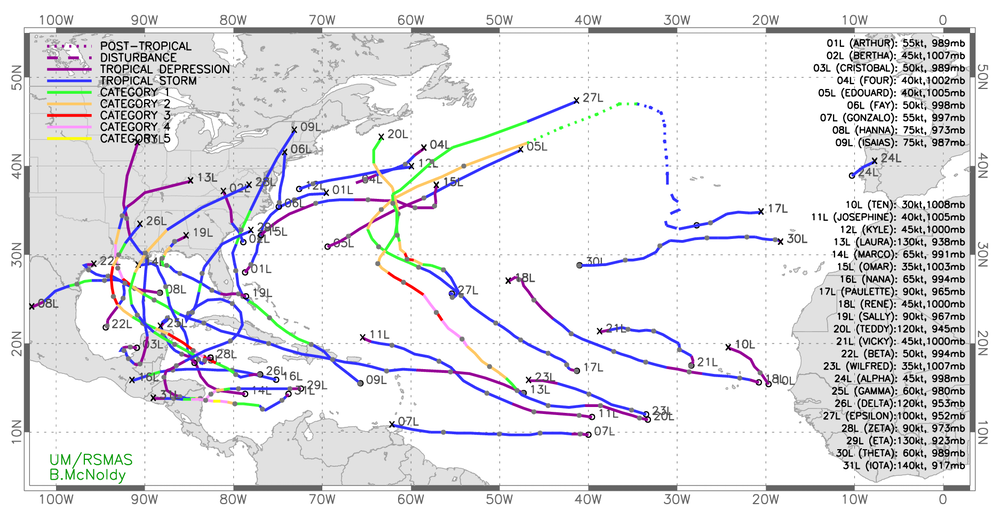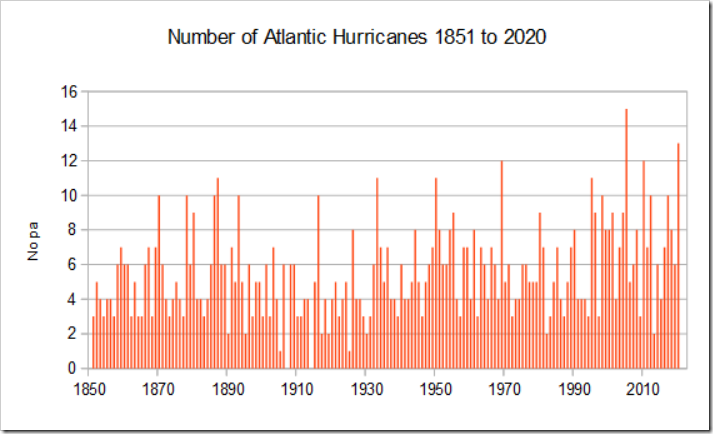No, It Was Not A Record Hurricane Season!
By Paul Homewood
Inevitably the busy hurricane season this year is getting blamed on global warming:
But first of all, let’s get one thing clear – there was not a record number of hurricanes this year in the Atlantic. There were 13 hurricanes, compared to 15 in 2005:
https://www.aoml.noaa.gov/hrd-faq/#tcs-after-1930
It is true that there were more named storms, which includes tropical storms as well as hurricanes, this season than in any other year, but this is quite meaningless. Over the years, reporting practices have drastically changed, so that more storms are spotted and named now.
As NOAA explain:
There has been a very pronounced increase in the number of tropical storms and hurricanes in the Atlantic since the late-1980s.
Existing records of past Atlantic tropical storm numbers (1878 to present) in fact do show a pronounced upward trend, correlated with rising SSTs (see Figs. 1 and 9 of Vecchi and Knutson 2008). However, the density of reporting ship traffic over the Atlantic was relatively sparse during the early decades of this record, such that if storms from the modern era (post 1965) had hypothetically occurred during those earlier decades, a substantial number would likely not have been directly observed by the ship-based “observing network of opportunity.” We find that, after adjusting for such an estimated number of missing storms, there is a small nominally positive upward trend in tropical storm occurrence from 1878-2006. But statistical tests reveal that this trend is so small, relative to the variability in the series, that it is not significantly distinguishable from zero (Figure 2). Thus the historical tropical storm count record does not provide compelling evidence for a greenhouse warming induced long-term increase.
Additionally, if one explores the tropical cyclone database for the Atlantic (HURDAT) more carefully, as was described by Landsea et al (2009), one notices that there has been a very substantial increase in the number of short-duration tropical storms (storms lasting less than two days), while those storms whose duration exceeds two days have not shown a statistically significant increase since the late-19th Century (particularly if they are adjusted for likely missing storms) – see Figure 1 above. We are unaware of a climate change signal that would result in an increase of only the shortest duration storms, while such an increase is qualitatively consistent with what one would expect from improvements with observational practices. Thus, we interpret the increase of short duration storms as further evidence for a spurious increase in Atlantic tropical storm counts since the late-19th Century.
https://www.gfdl.noaa.gov/historical-atlantic-hurricane-and-tropical-storm-records/
All of this applies to hurricanes just as much as storms. We now spot short lived hurricanes, which in the past would have been counted as just storms.
Dr Neil Frank, who was Director of the US National Hurricane Center from 1974 to 1987 goes further, maintaining that many of the storms now named would not have been in his day.
He makes two particular complaints about current methods:
1) Many named storms are actually winter storms, not tropical storms. He states that the first six tropical storms this year would not have been counted in his time.
2) Nowadays the NHC rushes to name a storm, simply based on wind speeds. His team would have waited until the central pressure dropped to confirm that it really was a tropical storm, and not just a thunderstorm. This often explains why named storms are often so short lasting now.
When we compare this year’s hurricane tracks with some other busy years, such as 1961 and 1969, the absence of mid-ocean storms in the latter years is immediately clear:

https://www.aoml.noaa.gov/hrd/hurdat/DataByYearandStorm.html
This year, there have been seventeen tropical storms – that is between 39 and 74mph. Yet in 1961 there were just three, and in 1969 six. Yet 1969 saw twelve hurricanes, only one less than this year, and 1961 had eight.
It is absurd to suppose that all storms were recorded in the 1960s.
When we look at major hurricanes, those of Cat 3 and over, a totally different picture emerges:
https://www.aoml.noaa.gov/hrd-faq/#tcs-after-1930
This year, there have been six such hurricanes, below the record of eight seen in 1950 and seven in 1961.
This data clearly implies that hurricanes are getting less intense on average. But is that right, given that global warming theory says the opposite? Or is it just that we spot many more smaller hurricanes now?
This chart shows a clear cyclical pattern, which NOAA explain:
Of course, if hurricanes really were becoming more frequent because of climate change, we would see it in the global trends.
But we don’t:
http://climatlas.com/tropical/
In reality, we only have reliable data on Atlantic hurricanes since the satellite era began in the 1970s. But the 1970s and 80s also coincided with the cold phase of the AMO. making comparisons now both misleading and meaningless.
What is absolutely clear from the data however is that since the AMO warm phase began in 1995, there has been little or no trend in hurricane activity.
Comments are closed.







The other issue is that the North Atlantic Basin, where tropical cyclones are called hurricanes, is just one of six cyclone basins. Tropical cyclone activity in a single cyclone basin does not contain useful information about the impact of AGW on tropical cyclones, much less a single season in a single basin. Pls see
https://tambonthongchai.com/2019/11/14/hurricane-obsession/
Yes globally, it is a divergent picture this year, and nothing exceptional over all.
http://climatlas.com/tropical/#
Thank you but “this year” is just one season. We need more than 30 consecutive seasons of data for all cyclone basins and then look for statistically significant trends in total accumulated cyclone energy. This is the only way to detect the effect of agw. All this excitement about a single season in a single basin is a nothingburger.
There are six basins which have tropical cyclones each year; and there is only slight correlation between them.
Once the six basins are aggregated into a GLOBAL picture, using ACE as the metric, 2020 emerges as a quiet year.
A dismal year for Hurricane Porn, but this has not stopped the usual crowd from trying to arrange a group orgy.
Actually, all this is pretty irrelevant. With Covid-19 around to distract them, the public no longer cares about Lashing Storms, or Melting Arctic Ice, or Dying Australian Corals; or just about any of the things that the propagandists worked so hard to rub up into emotional trigger images.
‘Lost Victories’ for them!
Good luck in getting these facts to the likes of McGrath and Horrorbin at the BBC.
You have to admire their barefaced lying
Paul… Your chart does not plot the hurricanes from 1851-2020. It plots those from 1930 forward. (as labeled in blue below). And a plot of MAJOR hurricanes since 1930 will show a downward trend.
The link also includes 1851-1930, but you need to click on the + sign
In case you missed it, the AMO, PDO etc. have gone the same way as the MWP, so you can cut out that excuse!
And we’re the deniers?
“Michael Mann? I don’t think he exists.”
He does, but not in the real world
He is a figment of his own imagination.
“…state-of-the-art climate model simulations…”
Say no more!
What has always been clear is that these pretend pictures of reality fall so far short, in every way, that they can not not be salvaged or improved into anything remotely respectable.
Yet here we are.
There seems to be some confusion? “The Pacific Decadal Oscillation (PDO) is a pattern of Pacific climate variability similar to ENSO in character, but which varies over a much longer time scale. The PDO can remain in the same phase for 20 to 30 years, while ENSO cycles typically only last 6 to 18 months.”
It is the ENSO (sea surface temperature anomalies) that creates all the “extreme” weather, including the Monsoons. Whether the PDO exists or not is irrelevant?
No confusion here. Are you confused? It’s complicated, no one thing…….
Not complicated. There is no correlation between the Nino3.4 sea surface temperature anomalies (natural variability) and Mauna Loa CO2…. man-made global warming.
Paul, I noticed this year (wish I screen grabbed), many tropical storms with maximum sustained winds of 45mph (just a gale on the Beaufort Scale). Hardly a tropical storm
Have NOAA lowered these values from previous years?
No, the tropical storm requirement has always been 39 mph and over, up until 74 mph.
O/T I note that the fatal explosion in Bristol today occurred at the GENeco anaerobic digester plant. The company’s stated aims are to help Wessex Water reduce their carbon footprint and ‘shape a renewable future’. That’s going well then. If the incident occurred at a fossil fuelled power station the BBC would be screaming to high heaven.
Good find, Mack!
RIP to the four workers. There’s a long history of anaerobic digesters exploding. Often due to inadequate safety procedures during maintenance.
https://www.dailymail.co.uk/news/article-9014157/Emergency-services-rush-large-explosion-warehouse-near-Bristol.html
https://www.geneco.uk.com/
Above at 3:34 pm, MrGrimNasty shows a note by Mann that climate ‘osillations’ (sic) are not “distinguishable from background noise”.
Very interesting.
Ten years ago a site called ‘skeptical science” was out with a post acknowledging the PDO.
Written by Nicholas Berini 16 Sept 2010
He claimed “Natural oscillations like PDO simply move heat around from oceans to air and vice-versa. They don’t have the ability to either create or retain heat, …”
{I have no idea who Nicholas Berini is, or was.}
According to our own beloved global-warming maniacs in the Meteorological Office, Mann is wrong:
“The Pacific Decadal Oscillation is [sic] a climate event.” No ifs or buts there.
Schisms in the Church!
I ask this everytime these claims appear – were SSTs in the right areas 2020 actually warmer than 2019?
Far too often I see the data on the effect without seeing the data on the cause – that seems to be simply assumed.
The CDAS Global Anomaly SST number has fallen steadily, in the last two months,
from + 0.30 C to +0.15 C.
A La Nina is in place.
The NOAA data are here…
https://origin.cpc.ncep.noaa.gov/products/analysis_monitoring/ensostuff/ONI_v5.php
As usual, a well argued, documented and informative article from Paul Homewood. WUWT also had an interesting analysis from Roger Pielke a few days ago:
One of the authors of the article is at Penn State University. One of the directors there is Michael Mann. Coincidence? I doubt it.
note that BBC panorama tonight (monday) 7.00 “Justin Rowlatt visits communities hit by this years extreme weather ” extreme? anyway expect the usual climate catastrophe bull